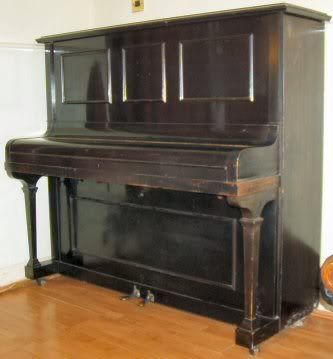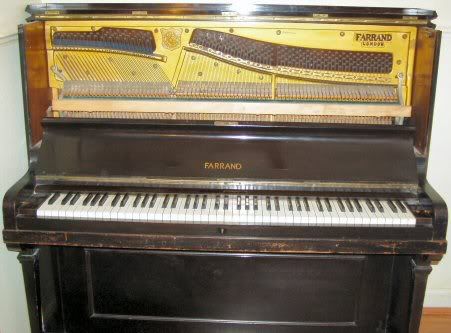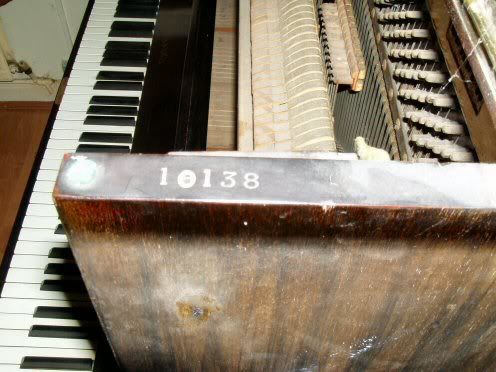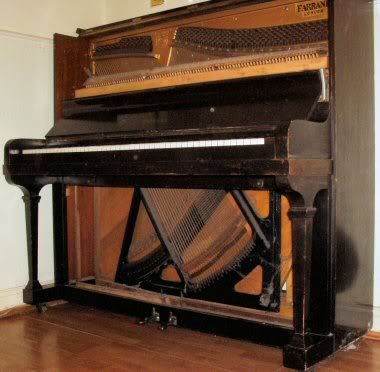Farrand piano
Ask questions on piano history and the age of your piano.
Moderators: Feg, Gill the Piano, Bill Kibby
Farrand piano
Hi, I wonder if anyone can help.
I have just been given a Farrand piano and I would like to know a little bit about it, particularly how old it might be.
It is an upright piano with an iron frame in what I think is a mahogany case. The gold painted frame has the name "FARRAND LONDON" cast into the top right hand corner. There is also a medalion with the words "THE AEOLIAN COMPANY LTD" and an AC monogram cast into the top of the frame, and the letters "FO" cast into the frame below the keyboard.
On the inside of the case, stamped into the wood of the side panels below the keyboard is "C7 29". And what I believe to be the serial number "10138" is stamped on the inside of the lower front panel and also into the top of the side panel so that it is easily visible when the lid is lifted.
The piano looks to be quite old but still plays ok and has quite a good tone, although it will benefit from a bit of a tune up and some TLC.
I would be very happy if anyone can shed any light on the history of this instrument for me.
Marc.
I have just been given a Farrand piano and I would like to know a little bit about it, particularly how old it might be.
It is an upright piano with an iron frame in what I think is a mahogany case. The gold painted frame has the name "FARRAND LONDON" cast into the top right hand corner. There is also a medalion with the words "THE AEOLIAN COMPANY LTD" and an AC monogram cast into the top of the frame, and the letters "FO" cast into the frame below the keyboard.
On the inside of the case, stamped into the wood of the side panels below the keyboard is "C7 29". And what I believe to be the serial number "10138" is stamped on the inside of the lower front panel and also into the top of the side panel so that it is easily visible when the lid is lifted.
The piano looks to be quite old but still plays ok and has quite a good tone, although it will benefit from a bit of a tune up and some TLC.
I would be very happy if anyone can shed any light on the history of this instrument for me.
Marc.
Re: Farrand piano
Farrand was an American brand which was owned by the Aeolian company, and most often used on player pianos, however regular pianos were also made under that name. It will most likely have come from the Aeolian factory at Hayes in the 1920s (others may be able to date it more accurately.)
The Farrand brand was usually applied to the cheapest models.
The Aeolian company was the main maker of player pianos in the UK, owning brands including "Orchestrelle" "Pianola" "Farrand" "Weber" "Steck". It also produced Aeolian and Vocalion gramophones, and early Vocalion discs.
As you don't mention it, I assume it has not previously been a player piano. Is this correct? I have had a Aeolian Farrand player piano in oak through my hands a couple of years back, and seen a Farrand non-player grand some time ago. They are usually well built and provided it is in good condition inside, should tune up OK. The player held its tune well at concert pitch despite not having been tuned for some time.
A photo would help.
The Farrand brand was usually applied to the cheapest models.
The Aeolian company was the main maker of player pianos in the UK, owning brands including "Orchestrelle" "Pianola" "Farrand" "Weber" "Steck". It also produced Aeolian and Vocalion gramophones, and early Vocalion discs.
As you don't mention it, I assume it has not previously been a player piano. Is this correct? I have had a Aeolian Farrand player piano in oak through my hands a couple of years back, and seen a Farrand non-player grand some time ago. They are usually well built and provided it is in good condition inside, should tune up OK. The player held its tune well at concert pitch despite not having been tuned for some time.
A photo would help.
Re: Farrand piano
Thanks for your response Pianomate. In answer to your question I don't think that this was ever a player piano, there doesn't seem to be any evidence of modification that I can see, but I am no expert. Maybe the pics below will shed a little more light.




I am pretty certain that the wood is mahogany not oak. The mechanics seem to be in good order and the tone is really quite good (to my uneducated ear). It is also reasonably in tune although will benefit from the attention of a tuner.
Marc.




I am pretty certain that the wood is mahogany not oak. The mechanics seem to be in good order and the tone is really quite good (to my uneducated ear). It is also reasonably in tune although will benefit from the attention of a tuner.
Marc.
Re: Farrand piano
The internals are quite different to the player I sold, however the style of the keybed and spindles looks identical.
I would agree that the finish appears to be mahogany, and the style is early to mid 1920s. It still has a classical style - Later instruments were more curved, and sloping fronts started to be introduced in the 1930s.
Although Farrand was usually aplied to the cheaper Aeolian models, they were often far superior to many other pianos of the day and the build quality is good.
Player actions themselves were expensive and were never fitted into poor quality instruments. The Farrand I sold did not have any accentuation or loudness functions which the more expensive models did, and this appears to have been the main difference, not the overall quality.
It would appear that your piano has never been a player.
If you take the fallboard off and can manage to extricate the far left key from the keybed, it often has a date written on the side.
It will requrie a good session with a tuner - it will need bringing in tune, regulating and almost certainly voicing as well. The marks on the woodwork would appear to be mainly cosmetic and could probably be tidied up in a single session if desired, but this would not darken any fading. The finish is almost certainly cellulose lacquer rather than French Polish if anyone asks.
I would agree that the finish appears to be mahogany, and the style is early to mid 1920s. It still has a classical style - Later instruments were more curved, and sloping fronts started to be introduced in the 1930s.
Although Farrand was usually aplied to the cheaper Aeolian models, they were often far superior to many other pianos of the day and the build quality is good.
Player actions themselves were expensive and were never fitted into poor quality instruments. The Farrand I sold did not have any accentuation or loudness functions which the more expensive models did, and this appears to have been the main difference, not the overall quality.
It would appear that your piano has never been a player.
If you take the fallboard off and can manage to extricate the far left key from the keybed, it often has a date written on the side.
It will requrie a good session with a tuner - it will need bringing in tune, regulating and almost certainly voicing as well. The marks on the woodwork would appear to be mainly cosmetic and could probably be tidied up in a single session if desired, but this would not darken any fading. The finish is almost certainly cellulose lacquer rather than French Polish if anyone asks.
- Bill Kibby
- Moderator

- Posts: 5684
- Joined: 04 Jun 2003, 19:25
- Location: Lincolnshire UK
- Contact:
Re: Farrand piano
Post by Bill Kibby »
I have already answered Marc a while ago. There are quite a few Farrand pianos around but I have never managed to find a definite date on any that I have tuned. The mark "Farrand London" confirms its origin. The mark FO cast into the iron frame sometimes means "Full Open", that is a full iron frame extending right up to the top of the piano, but with the wood in the wrestplank area exposed. This is one of the cheaper features on Farrand pianos, as opposed to most Aeolian / Pianola models. Their organ factory seems to have finished in 1918, taken over by Shenstone, but I don't know about pianos. I would guess this one was from the early twenties.
Piano History Centre
http://pianohistory.info
Email via my website.
If you find old references or links on this site to pianogen.org, they should refer to pianohistory.info
http://pianohistory.info
Email via my website.
If you find old references or links on this site to pianogen.org, they should refer to pianohistory.info
-
Cantabrigian
- New Member

- Posts: 3
- Joined: 17 Dec 2019, 13:29
Re: Farrand piano
Post by Cantabrigian »
This is a very old thread, and I know almost nothing about pianos - but despite this I may be able to help in this instance.
I've just passed on to some friends and their children an upright Farrand piano which looks identical to the one pictured. Its new berth just outside Cambridge is the piano's fourth home in total.
But its first was in Didcot, Berkshire (at the time). It was bought new for my father (aged 8) by his father in 1940, or just possibly 1941. It can't have been bought before 1939 because the family had moved from Wales that year and certainly didn't have the piano there.
So whilst I don't know how long a particular model stayed in production without any stylistic or cosmetic tweaks, but it is quite possible that the pictured piano is a bit more recent than the 1920s.
John
I've just passed on to some friends and their children an upright Farrand piano which looks identical to the one pictured. Its new berth just outside Cambridge is the piano's fourth home in total.
But its first was in Didcot, Berkshire (at the time). It was bought new for my father (aged 8) by his father in 1940, or just possibly 1941. It can't have been bought before 1939 because the family had moved from Wales that year and certainly didn't have the piano there.
So whilst I don't know how long a particular model stayed in production without any stylistic or cosmetic tweaks, but it is quite possible that the pictured piano is a bit more recent than the 1920s.
John
- Bill Kibby
- Moderator

- Posts: 5684
- Joined: 04 Jun 2003, 19:25
- Location: Lincolnshire UK
- Contact:
Re: Farrand piano
Post by Bill Kibby »
I have no trace of a piano in this style being made in the war, but what often happens is that a secondhand piano is bought for a child, and they don't know how old it was, so they think it is new.
That's the only logic I can offer.
That's the only logic I can offer.
Piano History Centre
http://pianohistory.info
Email via my website.
If you find old references or links on this site to pianogen.org, they should refer to pianohistory.info
http://pianohistory.info
Email via my website.
If you find old references or links on this site to pianogen.org, they should refer to pianohistory.info
-
Cantabrigian
- New Member

- Posts: 3
- Joined: 17 Dec 2019, 13:29
Re: Farrand piano
Post by Cantabrigian »
Thanks, Bill, and it's a joy to know this thread is still live.
What you say is perfectly reasonable and you clearly have a greater cohort of pianos from which to derive your expertise. Perhaps it is 1920's - perhaps it's probably 1920's.... but allow me to add a few more scraps of context and conjecture.
To be clear, I was talking about my father's piano specifically - not so much the one of the individual post. My father's could have been close the last produced of long-standing model - especially if as seems likely production stopped soon but not immediately into the War.
I admit I was almost sure it was new for my father - not just he (d. 1999) but my grandmother (d. 2001) implied this even if they didn't state it. I admit it's hard to remember with certainty at this distance. When I first remember the piano in the 1970's it was completely unscratched: my father was a stickler for such things as and adult and clearly had been at the time. It only acquired its first blemish when it was moved (for the first time since 1940) to my childhood home when I started piano lessons in 1980. I can remember exactly what my father said about (fortunately not to!) the removal men on that occasion. They were lucky he at work when they arrived with it!)
My father told me how much it had cost - 120 guineas, just possibly 100 gn - a lot of money: my grandfather was earning just £450 pa - though that was a good salary then and the move from Pembrokeshire to Didcot (he worked on the GWR) had been a significant promotion for him.
But whatever the figure, the guineas had definitely impressed my father as it did me when he first told that story in the late 1970's.
My understanding is that when things were priced in guineas (21/-) it was often to include an automatic 5% commission for the salesman/other party who'd then remit in pounds (20/-). That would suggest it was bought new. Failing that, I gather that high value, aspirational items tended to be advertised in guineas... it simultaneously added a touch of class and lowered the headline figure! I admit I suppose someone might do that in a 2nd hand classified advert but it seems less likely.
As for the unlikelihood of it's being made during the war: even if 1940 is correct as to year of my grandfather's acquisition (and I admit 1939 is just possible), it could have been very early 1940 - still well within the phoney war. I don't know how quickly or completely non-essential manufacturing was drastically scaled back . The Farrand in question is metal-framed with a vengeance - a fact borne in again on me when helping to move it this week and it does seem hard to imagine their continuing manufacture was a wartime priority. But even then the piano was presumably most likely manufactured sometime in 1939.
I'd always imagined my grandfather bought it because he'd just been promoted, had bought his first house (albeit with a mortgage) and even if his son of 7 rising 8 wasn't keen to start piano lessons, it would have confirmed his definite arrival in the middle class :-)
But it might have been more pragmatic. By February 1940, it might have been clear that if he wanted a new piano from an emptying warehouse or show room, he needed to get his skates on!
I'm going to look more closely at the Royal Crest in the "By Appointment" badge next time I see the piano. I'm hoping it will reference George VI (or even George V). This would settle it either side of 1936....
...but I've got a horrible feeling it's a generic By Appointment crest to no particular monarch!
I'll update when I've examined it. Don't get your hopes up!
What you say is perfectly reasonable and you clearly have a greater cohort of pianos from which to derive your expertise. Perhaps it is 1920's - perhaps it's probably 1920's.... but allow me to add a few more scraps of context and conjecture.
To be clear, I was talking about my father's piano specifically - not so much the one of the individual post. My father's could have been close the last produced of long-standing model - especially if as seems likely production stopped soon but not immediately into the War.
I admit I was almost sure it was new for my father - not just he (d. 1999) but my grandmother (d. 2001) implied this even if they didn't state it. I admit it's hard to remember with certainty at this distance. When I first remember the piano in the 1970's it was completely unscratched: my father was a stickler for such things as and adult and clearly had been at the time. It only acquired its first blemish when it was moved (for the first time since 1940) to my childhood home when I started piano lessons in 1980. I can remember exactly what my father said about (fortunately not to!) the removal men on that occasion. They were lucky he at work when they arrived with it!)
My father told me how much it had cost - 120 guineas, just possibly 100 gn - a lot of money: my grandfather was earning just £450 pa - though that was a good salary then and the move from Pembrokeshire to Didcot (he worked on the GWR) had been a significant promotion for him.
But whatever the figure, the guineas had definitely impressed my father as it did me when he first told that story in the late 1970's.
My understanding is that when things were priced in guineas (21/-) it was often to include an automatic 5% commission for the salesman/other party who'd then remit in pounds (20/-). That would suggest it was bought new. Failing that, I gather that high value, aspirational items tended to be advertised in guineas... it simultaneously added a touch of class and lowered the headline figure! I admit I suppose someone might do that in a 2nd hand classified advert but it seems less likely.
As for the unlikelihood of it's being made during the war: even if 1940 is correct as to year of my grandfather's acquisition (and I admit 1939 is just possible), it could have been very early 1940 - still well within the phoney war. I don't know how quickly or completely non-essential manufacturing was drastically scaled back . The Farrand in question is metal-framed with a vengeance - a fact borne in again on me when helping to move it this week and it does seem hard to imagine their continuing manufacture was a wartime priority. But even then the piano was presumably most likely manufactured sometime in 1939.
I'd always imagined my grandfather bought it because he'd just been promoted, had bought his first house (albeit with a mortgage) and even if his son of 7 rising 8 wasn't keen to start piano lessons, it would have confirmed his definite arrival in the middle class :-)
But it might have been more pragmatic. By February 1940, it might have been clear that if he wanted a new piano from an emptying warehouse or show room, he needed to get his skates on!
I'm going to look more closely at the Royal Crest in the "By Appointment" badge next time I see the piano. I'm hoping it will reference George VI (or even George V). This would settle it either side of 1936....
...but I've got a horrible feeling it's a generic By Appointment crest to no particular monarch!
I'll update when I've examined it. Don't get your hopes up!
-
molikotigo
- New Member

- Posts: 1
- Joined: 20 Dec 2019, 21:40
Re: Farrand piano
Post by molikotigo »
As you don't mention it, I assume it has not previously been a player piano. Is this correct? I have had a Aeolian Farrand player piano in oak through my hands a couple of years back, and seen a Farrand non-player grand some time ago. They are usually well built and provided it is in good condition inside, should tune up OK. The player held its tune well at concert pitch despite not having been tuned for some time.
-
Cantabrigian
- New Member

- Posts: 3
- Joined: 17 Dec 2019, 13:29
Re: Farrand piano
Post by Cantabrigian »
No, it's been established that the piano that was the the subject of the original post was not a player. And neither is the Farrand piano I've been posting about more recently.
Post Reply
11 posts
• Page 1 of 1
- Main Site Menu
-
Home
Piano Tuners
Piano Makers
Piano Accessories Shop
Piano Teachers
Piano Accompanists
Piano Entertainers
Piano Shops
Piano Removals
French Polishers
Piano Rehearsal Rooms
Piano Hire
Pianos For Sale
Piano Parts
Piano History
Piano Forum
Piano Music
Piano Events
Advertise
Advanced Search Contact Site Admin
Help with a listing
Sitemap
Main Terms And Conditions
-
- Recent Listings

